The Battle of Roundway Down, Devizes July 13th, 1643
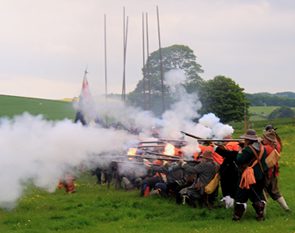
This was the most important Royalist cavalry victory of the Civil War. Victory gave the Royalists the key to securing the South-west, Bristol was soon captured. The potential was then there to attack London the Royalist's dream. But this dream was squandered in the failed attack on Gloucester and the subsequent campaigning.
Alan Carter is writing a book on the Siege of Devizes and the Battle of Roundway Down. It covers the parliamentary and King's armies following on from the Lansdown fight and looks at the immediate and long term military and political impacts of the battle and the huge parliamentary loss. The impacts on the local area and Wiltshire are explored. The impacts of the civil war on 6 of the military leaders, their families and their eventual fate following the civil war lends a novel insight into the Civil War that is far broader than this one battle. It should be ready by the latter half of 2019. Meanwhile there will be a chapter in Alan's Devizes in History book which is planned for Easter 2019. For many readers that will provide a good level of detail.
At Roundway Down Sir Ralph Hopton led the Royalist forces from Devizes Castle, but Lord Wilmot led the 1800 strong Royalist cavalry that came from King Charles at Oxford to relieve the Siege of Devizes. Sir William Waller the parliamentary Commander lost a battle that he expected to win. The defeat led to the capture of Bath and Bristol and for a while Royalist dominance of the south west of England. 600 were killed - mostly on the parliament side , 800 to 1000 parliamentary soldiers were captured along with all the parliament's artillery, baggage. 113 Royalist prisoners were released.
The Royalist commanders were Sir Ralph Hopton and Lord Henry Wilmot. The Parliamentary commanders were Sir William Waller and Sir Arthur Haselrige. The Parliamentary army consisted of about 2,500 horse and ca 1,800 foot soldiers and 8 guns.
However at Roundway Down the parliamentary cavalry were hungry and exhausted following Waller's active campaigning in Somerset and Wiltshire. The Royalist forces were somewhat smaller with 1800 horse and 2000 foot soldiers defending Devizes, who later came to support the cavalry and rout Waller's fleeing foot soldiers. They had only 2 light guns. The Parliamentary dead were estimated at 600 killed, but this is possibly a Royalist exaggeration. 1200 parliamentary men were captured. The Royalist number of dead is unknown.
Background The Royalist victory at Lansdown Hill on July 5th 1643 was a marginal one, Lord Hertford's Royalist army was in low spirits owing to heavy casualties, the death of Sir Bevil Grenville and serious injuries to Sir Ralph Hopton (Royalist). Most of the Royalist cavalry had scattered during the battle and the army was short of supplies and ammunition. After regrouping at Marshfield, the Royalists marched towards Oxford, halting for two days at Chippenham in Wiltshire. Meanwhile, Sir William Waller (Parliament) summoned reinforcements from Bristol and set off in pursuit of the battered Royalist army with an overwhelming force of nearly 5,000 men.
The Siege of Devizes, 9-13 July 1643 Sir Ralph Hopton was wounded at the Battle of Lansdowne and was carried on a chair from Bath, to Chippenham and on to Devizes. His forces were harassed by Sir William Waller's advance guard and Hopton lost 40 men killed as they fought a desperate rear guard action at the ford near Rowde just 2 miles from Devizes. They made it to the relative safety of Devizes on July 9th.
During the early part of the Civil War, Devizes castle was a Royalist fortress; the Castle was pressed into service, barricaded and defended. The Castle provided a base for Lord Hopton's force during the siege of Devizes and during the Battle of Roundway. They set up their artillery in the remains of the castle and barricaded the streets with tree trunks and carts, and lined the hedgerows around Devizes with infantry.
The Parliamentarians camped to the north in Roundway and had a force in Potterne too. Waller made sure that Roundway Hill, a down rising to a height of 795 feet two miles to the north of Devizes, was securely held by his cavalry. Waller allowed the Royalists a brief respite. On 10 July, however, he offered Hopton the opportunity for a general engagement, drawing his whole army up on Roundway Hill while the Royalist cavalry deployed on Coatefield Hill to the east of the town. Desperately short of powder and ammunition, outnumbered in cavalry, and with their commander still temporarily blinded and paralysed, the Royalists stayed with in Devizes.
On 11 July troopers from Waller's own regiment of cavalry intercepted the Earl of Crawford who was approaching Devizes from the north-east with 600 Royalist cavalry and a re-supply of ammunition for Hopton. In a confused night skirmish Crawford's force was scattered and the ammunition captured. Although this clash had boosted Waller's immediate prospects of success he was concerned at the apparent ease with which the Royalists could leave Oxford to bring relief to Devizes. Waller urged the Earl of Essex, whose army was watching Oxford, to prevent any further intervention from the Royalist capital.
On the 11 and 12th of July the castle and town were bombarded by parliamentary guns and there was hand to hand fighting as far into town as Morris Lane. St. John's Church was store for gunpowder and this became a target during the siege. The action probably took place from Morris Lane. . There was a rectory in the church yard fronting on Long Street where the community hall now stands; this was a rectory in the church yard fronting on Long Street where the community hall now stands; this was destroyed in the action and a new one eventually built at 39 Long Street. There are some 22 holes made by grapeshot - about 1.5 inches in diameter- fired from a cannon in a cloth or leather bag. I suspect that this pattern was made by two grapeshot hits - above right
During the Civil War cannon balls also hit St. James Church. The holes can still be seen on the tower - left. The cannon ball holes are on the east side of the tower, bottom left and top right. These cannon balls are in the Wiltshire Museum, Devizes, but are not on display. They are made of iron and weigh 1.011 and 1.147 kg respectively (two and half pounds in old money).
The Parliamentary army's guns, Falcon field guns, were situated in Coatefield somewhere near the old Jump Farm. They were firing at Devizes including St. James which presumably was part of theTown defences. This was on Wednesday 12th July 1643, the day before the Battle of Roundway.
A convoy of gunpowder and ammunition had been sent from Oxford to re-supply Hopton at Devizes under the command of the Earl of Crawford. But troopers of Waller's own regiment of horse under Major Dowett ambushed the convoy on the night of 11 July. The Royalist cavalry escort was scattered, 200 captured and the convoy captured. The remainder of Crawford's men rendezvoused with and joined the Oxford relief horse in Marlborough and came back to Roundway Down on the 13th of July.
While no infantry could be spared from Oxford, a relief force of 1,500 horse was detached under the command of Lord Wilmot, supported by Sir John Byron and the Earl of Crawford. Prince Maurice, Lord Carnarvon and the 300 horse that had ridden from Devizes also joined the column. Two brass field guns and a supply of gunpowder and ammunition were requisitioned. The relief force rendezvoused at Marlborough on 12 July and approached Devizes on the afternoon of the following day. Meanwhile at Devizes, Waller had deployed his forces on the eastern side of the town and set up a battery on Coatefield Hill. Sir Ralph Hopton initiated treaty negotiations on 11 July, which gained a day's respite, but Waller suspected that he was playing for time and proceeded with preparations for an assault. Although short of gunpowder and ammunition, the Royalists set up their artillery in the remains of Devizes Castle, barricaded the streets with tree trunks and carts, and lined the hedgerows and embankments around the town with musketeers. The Parliamentarians attacked on the morning of 12 July, supported by artillery fire from Coatefield Hill. The castle and town were bombarded by parliamentary guns and there was hand to hand fighting as far into town as Morris Lane. The Royalists resisted fiercely; although some of the outworks were overrun, the main Parliamentarian attack was repulsed.
The Battle of Roundway Down, 13 July 1643.
At a council of war on 10 July, in the Castle, Sir Ralph Hopton agreed to defend Devizes with the infantry and artillery while Prince Maurice rode to Oxford for reinforcements with Lord Hertford and Lord Carnarvon. Maurice broke out at midnight with 300 cavalry, riding south-east to evade Waller's patrols before turning north for Oxford. Prince Maurice and his companions rode the forty-five miles from Devizes to Oxford in a single night. When they arrived, they found that most of the Oxford army was in the Midlands with Prince Rupert.
Sir William Waller (Parliament) was planning further attacks on Devizes for the evening of July 13th when his scouts (dragoons) reported the approach of Wilmot's relief force of about 1800 horse (cavalry) from Oxford during the morning of 13 July. Waller without trumpets ofr drums removed his men form the siege of Devizes and deployed them ion Roundway Down
Above the battlefield from Roundway Hill - the hill immediately behind the village of Roundway. This is just near the end of the tarred road leading to Oliver's castle. Morgan's Hill is on the central skyline and far right, just behind the wood, is the high point of Roundway Down 242 m. The whole Down at that time was also known as Bagdon Hill. This was corrupted by Captain Harley, Parliamentary Horse, in his account as Bagnall Hill.
Some believe that Waller would have deployed across the Bath Marlborough old coach road, but this sems unlikely. There were two roads that led to Devizes from Shepherd's Shore, the gap in the Wansdyke on the Marlborough Bath road. One led over the Down and down the hill into Roundway village and the other further north along the route next to the Old Stone pits.
The Parliamentary army consisted of around 2,500 foot and between 2,500 and 3,000 horse and dragoons, supported by eight field guns. Waller deployed his troops conventionally, with five regiments of foot in the centre guarded by cavalry on each flank and artillery covering the gaps between. The Parliamentarian army was double the size of the Royalist relief force.
Lords Wilmot and Hertford rode from Oxford with about 1500 men. They spent the night of July 12th in Marlborough where they re-grouped cavalry of the Earl of Crawford. They had been driven off the night before by Waller's men trying to get ammunition to Devizes. So the Royalist relief force mounted to between 1800 and 2000 men with no infantry. However it must be remembered that there were 3000 Cornish infantry in Devizes Castle; these provided a considerable threat to Waller's rear. Lord Wilmot, the Royalist commander, hoped that Hopton would send out the Cornish foot (infantry) stationed in Devizes to support his horse(cavalry), but Hopton was persuaded to delay by his officers, who suspected that Waller's withdrawal was a stratagem to tempt them to leave the town.
If
this was the site of the initial deployment of Waller's army then it
was a very small site for 5000 men and 8 cannon. But it does have an
advantage in controlling the approach to Devizes and forcing Lord
Wilmot's group to march uphill. It gave a view of any approach of the
Royalist Cornish troops from Devizes and again would have forced them to
approach uphill too. But there is no archaeological evidence yet
discovered that supports this site. Above is a summary map showing known civil war grave sites and cannon ball finds. This is discussed in detail in appendix 1. But what this shows is that there was considerable activity in the vicinity of the modern Oliver's castle car park. Option 2 developed by Alan Carter seeks to explain this as the site of the intense bombardment of the parliamentary infantry leading to their surrender and may deaths.
Below is an other option for the initial deployment of the battle. It is argued that this site explains the archaeological finds on the above map and discussed in appendix 1 It is also consistent with the contemporary accounts detailed in Appendix 2. The yellow road on the map below is the London Bath coach road.
The Parliamentary foot or infantry, which played no early role in the battle, might have been anchored as shown from about 200 m from the Oliver's castle car park, or more likely further north east than this some 800 m from the Oliver's castle car park. Their final destruction and surrender possibly took place around there. The evidence for this is discussed in detail in appendix 1. Briefly 12 lead cannon balls were found between the square and what is now the Covert woods and on the square site itself a concentratin of musket and pistol shot in a constrained area were found by Keith Genever metal detector in 1975.
Wilmot deployed the Royalist cavalry in three brigades. He personally led the brigade on the left while Sir John Byron commanded on the right. The Earl of Crawford kept a third brigade in reserve; this was because they had been badly beaten 2 days earlier by Waller's troopers in a night battle when a relief ammunition column from Oxford was captured.
The battle began at about 3 o'clock in the afternoon of 13 July 1643. As the Royalists moved forward, a Parliamentarian forlorn hope advanced to harass them. Major Paul Smith of Wilmot's regiment led a Royalist forlorn hope to counter-attack, and the Parliamentarians were thrown back. Sir Arthur Heselrige on the Parliamentarian right wing advanced his formidable cuirassier regiment to support the fleeing troopers. Heselrige's troops were arrayed six deep in close order; his charge was met by Wilmot's brigade which advanced at a trot three deep in extended order. When the opposing ranks met, Wilmot's line overlapped Heselrige's and the Parliamentarians gave ground. Heselrige rallied his men for a second charge but seeing the second Royalist brigade ready to support Wilmot, the cuirassiers broke away and fled. This small action was instrumental in losing the battle for Parliament. Haselrige had passed in front of his own guns neutralising their effect as they could not then fire at the enemy.
With Haselrige's Lobsters routed, Sir William Waller advanced on the left with the right wing of horse flanking his infantry. Byron's brigade charged Waller's horse, steadfastly ignoring the covering fire from the Parliamentarian foot and artillery. Byron ordered his troopers not to fire their pistols until they were among the Parliamentarian horse. Supported by Lord Crawford's reserve, Byron swept the Parliamentarian left wing from the field. It was at this stage that the last 4 of the Parliament's cannons were captured. The triumphant Royalists pursued the fleeing Parliamentarian cavalry, a number of whom were driven over the edge of precipitous slopes on the edge of Roundway Down into the Bloody ditch at the bottom of the hill. 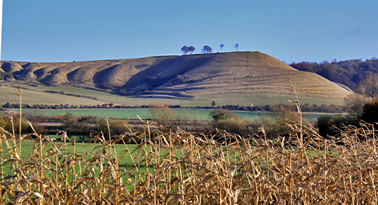
Above right Bloody Ditch is at the bottom the hill near the hedge. Photo courtesy Robert Marshall. Above left these steep slopes are seen from Bromham. Oliver's castle (an Iron Age fort) is the hill with the 5 trees. The battle started north of the Roundway Covert - the trees on the photo's top right. 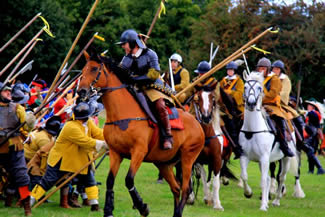
Whilst one troop of cavalry were chasing Waller's Horse away, the remaining Cavalry attacked the 2500 strong infantry square. Parliament held off for over an hour. Pike supported by musketeers are difficult to break down - below.
As the Royalist cavalry returned from the chase two (possibly 4) of the Parliament's cannons were captured.
It is probable that whilst the cavalry battle and chases were taking place that Waller's infantry
Right: Colonel Alexander Popham of Somerset and was born at Littlecote House, Hungerford. He was MP for Bath and a Deputy Lieutenant of Somerset. He was a Colonel of his Parliamentary Foot regiment on Roundway Down with 600 men, many of whom were killed.
The Royalists, using the captured cannon were firing both lead and iron 2 to 3 lb shot probably mixed with grape shot. Grape shot consists of 10 to 15 small 1.5 cm lead balls in wooden canisters or wrapped in a muslin bag. These were devastating and one grapeshot or canister shot could have killed 10-12 men. It is this action that probably accounted for the majority of the 600 parliamentary dead.
As noted below 1 iron and 11 lead cannon balls
have been found south of the infantry square.When the 3,000 Cornish
infantry finally marched out of Devizes Castle and advanced towards the
battlefield, Waller ordered a retreat. The Parliamentary infantry began
to march off in g
Many were cut down and soon the remainder, about 1200 put down their arms and surrendered. At this stage if the Civil War it is likely that this surrender would have been accepted as massacres only occurred after 1646. Hundreds were cut down or taken prisoner, many dying in an area still known as Bloody Ditch at the foot of the hillside. All Waller's artillery, ammunition and baggage was taken. Parliament's entire Western Association army had been wiped out in the most sweeping victory of the civil wars. The Parliamentary dead were estimated at 600 killed, but this is possibly a Royalist exaggeration. 1200 parliamentary men were captured. The Royalist number of dead is unknown.
A contributory factor in Waller's defeat was the extreme tiredness of his troops, due to active, prolonged campaigning and to a lack of food for his men. Nevertheless it was an outstanding victory for a smaller cavalry force.
There are many accounts of the action given by the participants and these details are very interesting. Keith Genever is to be congratulated on coming forward with his finds and maps. He has made a very significant contribution to defining the battle site in more detail and providing artefacts that are 367 years old.
|

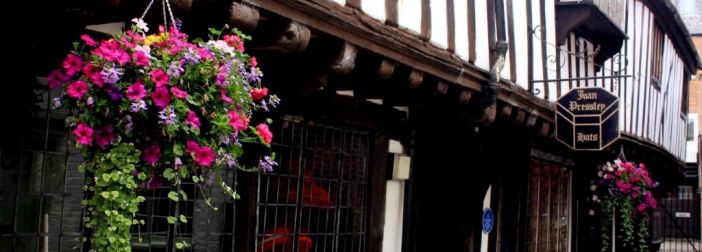


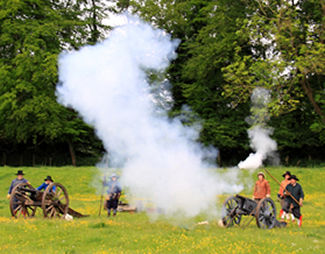 Right are
two replica 1653 cannons which fire up to 3lb balls. These photos were
taken at the Aldbourne, Wiltshire skirmish in May 2010 at an English
Civil War Society event. Other photos are available in the
Right are
two replica 1653 cannons which fire up to 3lb balls. These photos were
taken at the Aldbourne, Wiltshire skirmish in May 2010 at an English
Civil War Society event. Other photos are available in the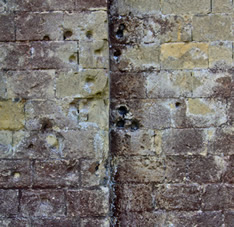



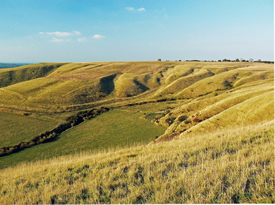
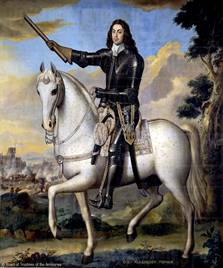 began
a controlled retreat in the direction of Oliver's castle and the Bath
Road. This shown on the option 2 map above.The Royalist turned the
captured cannons onto the infantry square.
began
a controlled retreat in the direction of Oliver's castle and the Bath
Road. This shown on the option 2 map above.The Royalist turned the
captured cannons onto the infantry square.